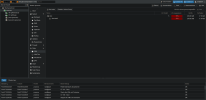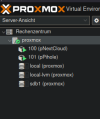Moin,
In der Weboberfläche wird mir angezeigt das anscheinen das Verzeichnis /dev/nvme0n1p3 zu 97% ausgelastet wird. Ist das normal oder liegt ein Fehler vor in meiner Proxmox Installation? Bisher habe ich keine Probleme bemerkt.
In der Weboberfläche wird mir angezeigt das anscheinen das Verzeichnis /dev/nvme0n1p3 zu 97% ausgelastet wird. Ist das normal oder liegt ein Fehler vor in meiner Proxmox Installation? Bisher habe ich keine Probleme bemerkt.
proxmox-ve: 6.3-1 (running kernel: 5.4.78-2-pve)
pve-manager: 6.3-3 (running version: 6.3-3/eee5f901)
pve-kernel-5.4: 6.3-3
pve-kernel-helper: 6.3-3
pve-kernel-5.4.78-2-pve: 5.4.78-2
pve-kernel-5.4.78-1-pve: 5.4.78-1
pve-kernel-5.4.73-1-pve: 5.4.73-1
pve-kernel-5.4.65-1-pve: 5.4.65-1
pve-kernel-5.4.34-1-pve: 5.4.34-2
ceph-fuse: 12.2.11+dfsg1-2.1+b1
corosync: 3.0.4-pve1
criu: 3.11-3
glusterfs-client: 5.5-3
ifupdown: 0.8.35+pve1
ksm-control-daemon: 1.3-1
libjs-extjs: 6.0.1-10
libknet1: 1.16-pve1
libproxmox-acme-perl: 1.0.7
libproxmox-backup-qemu0: 1.0.2-1
libpve-access-control: 6.1-3
libpve-apiclient-perl: 3.1-3
libpve-common-perl: 6.3-2
libpve-guest-common-perl: 3.1-3
libpve-http-server-perl: 3.1-1
libpve-storage-perl: 6.3-3
libqb0: 1.0.5-1
libspice-server1: 0.14.2-4~pve6+1
lvm2: 2.03.02-pve4
lxc-pve: 4.0.3-1
lxcfs: 4.0.3-pve3
novnc-pve: 1.1.0-1
proxmox-backup-client: 1.0.6-1
proxmox-mini-journalreader: 1.1-1
proxmox-widget-toolkit: 2.4-3
pve-cluster: 6.2-1
pve-container: 3.3-2
pve-docs: 6.3-1
pve-edk2-firmware: 2.20200531-1
pve-firewall: 4.1-3
pve-firmware: 3.1-3
pve-ha-manager: 3.1-1
pve-i18n: 2.2-2
pve-qemu-kvm: 5.1.0-7
pve-xtermjs: 4.7.0-3
qemu-server: 6.3-2
smartmontools: 7.1-pve2
spiceterm: 3.1-1
vncterm: 1.6-2
zfsutils-linux: 0.8.5-pve1
pve-manager: 6.3-3 (running version: 6.3-3/eee5f901)
pve-kernel-5.4: 6.3-3
pve-kernel-helper: 6.3-3
pve-kernel-5.4.78-2-pve: 5.4.78-2
pve-kernel-5.4.78-1-pve: 5.4.78-1
pve-kernel-5.4.73-1-pve: 5.4.73-1
pve-kernel-5.4.65-1-pve: 5.4.65-1
pve-kernel-5.4.34-1-pve: 5.4.34-2
ceph-fuse: 12.2.11+dfsg1-2.1+b1
corosync: 3.0.4-pve1
criu: 3.11-3
glusterfs-client: 5.5-3
ifupdown: 0.8.35+pve1
ksm-control-daemon: 1.3-1
libjs-extjs: 6.0.1-10
libknet1: 1.16-pve1
libproxmox-acme-perl: 1.0.7
libproxmox-backup-qemu0: 1.0.2-1
libpve-access-control: 6.1-3
libpve-apiclient-perl: 3.1-3
libpve-common-perl: 6.3-2
libpve-guest-common-perl: 3.1-3
libpve-http-server-perl: 3.1-1
libpve-storage-perl: 6.3-3
libqb0: 1.0.5-1
libspice-server1: 0.14.2-4~pve6+1
lvm2: 2.03.02-pve4
lxc-pve: 4.0.3-1
lxcfs: 4.0.3-pve3
novnc-pve: 1.1.0-1
proxmox-backup-client: 1.0.6-1
proxmox-mini-journalreader: 1.1-1
proxmox-widget-toolkit: 2.4-3
pve-cluster: 6.2-1
pve-container: 3.3-2
pve-docs: 6.3-1
pve-edk2-firmware: 2.20200531-1
pve-firewall: 4.1-3
pve-firmware: 3.1-3
pve-ha-manager: 3.1-1
pve-i18n: 2.2-2
pve-qemu-kvm: 5.1.0-7
pve-xtermjs: 4.7.0-3
qemu-server: 6.3-2
smartmontools: 7.1-pve2
spiceterm: 3.1-1
vncterm: 1.6-2
zfsutils-linux: 0.8.5-pve1
fdisk -l
Disk /dev/loop0: 50 GiB, 53687091200 bytes, 104857600 sectors
Units: sectors of 1 * 512 = 512 bytes
Sector size (logical/physical): 512 bytes / 512 bytes
I/O size (minimum/optimal): 512 bytes / 512 bytes
Disk /dev/nvme0n1: 465.8 GiB, 500107862016 bytes, 976773168 sectors
Disk model: Samsung SSD 970 EVO 500GB
Units: sectors of 1 * 512 = 512 bytes
Sector size (logical/physical): 512 bytes / 512 bytes
I/O size (minimum/optimal): 512 bytes / 512 bytes
Disklabel type: gpt
Disk identifier: 847FEC37-83DC-4E1D-A72D-C577421BE247
Device Start End Sectors Size Type
/dev/nvme0n1p1 34 2047 2014 1007K BIOS boot
/dev/nvme0n1p2 2048 1050623 1048576 512M EFI System
/dev/nvme0n1p3 1050624 976773134 975722511 465.3G Linux LVM
Disk /dev/sda: 238.5 GiB, 256060514304 bytes, 500118192 sectors
Disk model: M4-CT256M4SSD2
Units: sectors of 1 * 512 = 512 bytes
Sector size (logical/physical): 512 bytes / 512 bytes
I/O size (minimum/optimal): 512 bytes / 512 bytes
Disk /dev/sdb: 931.5 GiB, 1000204886016 bytes, 1953525168 sectors
Disk model: TOSHIBA MQ02ABF1
Units: sectors of 1 * 512 = 512 bytes
Sector size (logical/physical): 512 bytes / 4096 bytes
I/O size (minimum/optimal): 4096 bytes / 4096 bytes
Disklabel type: gpt
Disk identifier: 1340AA31-D12B-4660-A7E6-49783817F463
Device Start End Sectors Size Type
/dev/sdb1 2048 1953525134 1953523087 931.5G Linux filesystem
Disk /dev/mapper/pve-swap: 8 GiB, 8589934592 bytes, 16777216 sectors
Units: sectors of 1 * 512 = 512 bytes
Sector size (logical/physical): 512 bytes / 512 bytes
I/O size (minimum/optimal): 512 bytes / 512 bytes
Disk /dev/mapper/pve-root: 96 GiB, 103079215104 bytes, 201326592 sectors
Units: sectors of 1 * 512 = 512 bytes
Sector size (logical/physical): 512 bytes / 512 bytes
I/O size (minimum/optimal): 512 bytes / 512 bytes
Disk /dev/mapper/pve-vm--103--disk--0: 10 GiB, 10737418240 bytes, 20971520 sectors
Units: sectors of 1 * 512 = 512 bytes
Sector size (logical/physical): 512 bytes / 512 bytes
I/O size (minimum/optimal): 65536 bytes / 65536 bytes
Disk /dev/mapper/pve-vm--101--disk--0: 8 GiB, 8589934592 bytes, 16777216 sectors
Units: sectors of 1 * 512 = 512 bytes
Sector size (logical/physical): 512 bytes / 512 bytes
I/O size (minimum/optimal): 65536 bytes / 65536 bytes
Disk /dev/mapper/pve-vm--100--disk--0: 8 GiB, 8589934592 bytes, 16777216 sectors
Units: sectors of 1 * 512 = 512 bytes
Sector size (logical/physical): 512 bytes / 512 bytes
I/O size (minimum/optimal): 65536 bytes / 65536 bytes
Disk /dev/mapper/pve-vm--104--disk--0: 28 GiB, 30064771072 bytes, 58720256 sectors
Units: sectors of 1 * 512 = 512 bytes
Sector size (logical/physical): 512 bytes / 512 bytes
I/O size (minimum/optimal): 65536 bytes / 65536 bytes
Disk /dev/mapper/sdadisk: 238.5 GiB, 256043737088 bytes, 500085424 sectors
Units: sectors of 1 * 512 = 512 bytes
Sector size (logical/physical): 512 bytes / 512 bytes
I/O size (minimum/optimal): 512 bytes / 512 bytes
Disk /dev/loop0: 50 GiB, 53687091200 bytes, 104857600 sectors
Units: sectors of 1 * 512 = 512 bytes
Sector size (logical/physical): 512 bytes / 512 bytes
I/O size (minimum/optimal): 512 bytes / 512 bytes
Disk /dev/nvme0n1: 465.8 GiB, 500107862016 bytes, 976773168 sectors
Disk model: Samsung SSD 970 EVO 500GB
Units: sectors of 1 * 512 = 512 bytes
Sector size (logical/physical): 512 bytes / 512 bytes
I/O size (minimum/optimal): 512 bytes / 512 bytes
Disklabel type: gpt
Disk identifier: 847FEC37-83DC-4E1D-A72D-C577421BE247
Device Start End Sectors Size Type
/dev/nvme0n1p1 34 2047 2014 1007K BIOS boot
/dev/nvme0n1p2 2048 1050623 1048576 512M EFI System
/dev/nvme0n1p3 1050624 976773134 975722511 465.3G Linux LVM
Disk /dev/sda: 238.5 GiB, 256060514304 bytes, 500118192 sectors
Disk model: M4-CT256M4SSD2
Units: sectors of 1 * 512 = 512 bytes
Sector size (logical/physical): 512 bytes / 512 bytes
I/O size (minimum/optimal): 512 bytes / 512 bytes
Disk /dev/sdb: 931.5 GiB, 1000204886016 bytes, 1953525168 sectors
Disk model: TOSHIBA MQ02ABF1
Units: sectors of 1 * 512 = 512 bytes
Sector size (logical/physical): 512 bytes / 4096 bytes
I/O size (minimum/optimal): 4096 bytes / 4096 bytes
Disklabel type: gpt
Disk identifier: 1340AA31-D12B-4660-A7E6-49783817F463
Device Start End Sectors Size Type
/dev/sdb1 2048 1953525134 1953523087 931.5G Linux filesystem
Disk /dev/mapper/pve-swap: 8 GiB, 8589934592 bytes, 16777216 sectors
Units: sectors of 1 * 512 = 512 bytes
Sector size (logical/physical): 512 bytes / 512 bytes
I/O size (minimum/optimal): 512 bytes / 512 bytes
Disk /dev/mapper/pve-root: 96 GiB, 103079215104 bytes, 201326592 sectors
Units: sectors of 1 * 512 = 512 bytes
Sector size (logical/physical): 512 bytes / 512 bytes
I/O size (minimum/optimal): 512 bytes / 512 bytes
Disk /dev/mapper/pve-vm--103--disk--0: 10 GiB, 10737418240 bytes, 20971520 sectors
Units: sectors of 1 * 512 = 512 bytes
Sector size (logical/physical): 512 bytes / 512 bytes
I/O size (minimum/optimal): 65536 bytes / 65536 bytes
Disk /dev/mapper/pve-vm--101--disk--0: 8 GiB, 8589934592 bytes, 16777216 sectors
Units: sectors of 1 * 512 = 512 bytes
Sector size (logical/physical): 512 bytes / 512 bytes
I/O size (minimum/optimal): 65536 bytes / 65536 bytes
Disk /dev/mapper/pve-vm--100--disk--0: 8 GiB, 8589934592 bytes, 16777216 sectors
Units: sectors of 1 * 512 = 512 bytes
Sector size (logical/physical): 512 bytes / 512 bytes
I/O size (minimum/optimal): 65536 bytes / 65536 bytes
Disk /dev/mapper/pve-vm--104--disk--0: 28 GiB, 30064771072 bytes, 58720256 sectors
Units: sectors of 1 * 512 = 512 bytes
Sector size (logical/physical): 512 bytes / 512 bytes
I/O size (minimum/optimal): 65536 bytes / 65536 bytes
Disk /dev/mapper/sdadisk: 238.5 GiB, 256043737088 bytes, 500085424 sectors
Units: sectors of 1 * 512 = 512 bytes
Sector size (logical/physical): 512 bytes / 512 bytes
I/O size (minimum/optimal): 512 bytes / 512 bytes
config {
checks=1
abort_on_errors=0
profile_dir="/etc/lvm/profile"
}
local {
}
dmeventd {
mirror_library="libdevmapper-event-lvm2mirror.so"
snapshot_library="libdevmapper-event-lvm2snapshot.so"
thin_library="libdevmapper-event-lvm2thin.so"
}
activation {
checks=0
udev_sync=1
udev_rules=1
verify_udev_operations=0
retry_deactivation=1
missing_stripe_filler="error"
use_linear_target=1
reserved_stack=64
reserved_memory=8192
process_priority=-18
raid_region_size=2048
readahead="auto"
raid_fault_policy="warn"
mirror_image_fault_policy="remove"
mirror_log_fault_policy="allocate"
snapshot_autoextend_threshold=100
snapshot_autoextend_percent=20
thin_pool_autoextend_threshold=100
thin_pool_autoextend_percent=20
vdo_pool_autoextend_threshold=100
use_mlockall=0
monitoring=1
polling_interval=15
activation_mode="degraded"
}
global {
umask=63
test=0
units="r"
si_unit_consistency=1
suffix=1
activation=1
proc="/proc"
etc="/etc"
wait_for_locks=1
locking_dir="/run/lock/lvm"
prioritise_write_locks=1
abort_on_internal_errors=0
metadata_read_only=0
mirror_segtype_default="raid1"
raid10_segtype_default="raid10"
sparse_segtype_default="thin"
event_activation=1
use_lvmlockd=0
system_id_source="none"
use_lvmpolld=1
notify_dbus=1
}
shell {
history_size=100
}
backup {
backup=1
backup_dir="/etc/lvm/backup"
archive=1
archive_dir="/etc/lvm/archive"
retain_min=10
retain_days=30
}
log {
verbose=0
silent=0
syslog=1
overwrite=0
level=0
indent=1
command_names=0
prefix=" "
activation=0
debug_classes=["memory","devices","io","activation","allocation","metadata","cache","locking","lvmpolld","dbus"]
}
allocation {
maximise_cling=1
use_blkid_wiping=1
wipe_signatures_when_zeroing_new_lvs=1
mirror_logs_require_separate_pvs=0
cache_pool_metadata_require_separate_pvs=0
thin_pool_metadata_require_separate_pvs=0
}
devices {
dir="/dev"
scan="/dev"
obtain_device_list_from_udev=1
external_device_info_source="none"
global_filter=["r|/dev/zd.*|","r|/dev/mapper/pve-.*|","r|/dev/sdb*|","r|/dev/mapper/.*-(vm|base)--[0-9]+--disk--[0-9]+|"]
sysfs_scan=1
scan_lvs=1
multipath_component_detection=1
md_component_detection=1
fw_raid_component_detection=0
md_chunk_alignment=1
data_alignment_detection=1
data_alignment=0
data_alignment_offset_detection=1
ignore_suspended_devices=0
ignore_lvm_mirrors=1
require_restorefile_with_uuid=1
pv_min_size=2048
issue_discards=1
allow_changes_with_duplicate_pvs=0
}
checks=1
abort_on_errors=0
profile_dir="/etc/lvm/profile"
}
local {
}
dmeventd {
mirror_library="libdevmapper-event-lvm2mirror.so"
snapshot_library="libdevmapper-event-lvm2snapshot.so"
thin_library="libdevmapper-event-lvm2thin.so"
}
activation {
checks=0
udev_sync=1
udev_rules=1
verify_udev_operations=0
retry_deactivation=1
missing_stripe_filler="error"
use_linear_target=1
reserved_stack=64
reserved_memory=8192
process_priority=-18
raid_region_size=2048
readahead="auto"
raid_fault_policy="warn"
mirror_image_fault_policy="remove"
mirror_log_fault_policy="allocate"
snapshot_autoextend_threshold=100
snapshot_autoextend_percent=20
thin_pool_autoextend_threshold=100
thin_pool_autoextend_percent=20
vdo_pool_autoextend_threshold=100
use_mlockall=0
monitoring=1
polling_interval=15
activation_mode="degraded"
}
global {
umask=63
test=0
units="r"
si_unit_consistency=1
suffix=1
activation=1
proc="/proc"
etc="/etc"
wait_for_locks=1
locking_dir="/run/lock/lvm"
prioritise_write_locks=1
abort_on_internal_errors=0
metadata_read_only=0
mirror_segtype_default="raid1"
raid10_segtype_default="raid10"
sparse_segtype_default="thin"
event_activation=1
use_lvmlockd=0
system_id_source="none"
use_lvmpolld=1
notify_dbus=1
}
shell {
history_size=100
}
backup {
backup=1
backup_dir="/etc/lvm/backup"
archive=1
archive_dir="/etc/lvm/archive"
retain_min=10
retain_days=30
}
log {
verbose=0
silent=0
syslog=1
overwrite=0
level=0
indent=1
command_names=0
prefix=" "
activation=0
debug_classes=["memory","devices","io","activation","allocation","metadata","cache","locking","lvmpolld","dbus"]
}
allocation {
maximise_cling=1
use_blkid_wiping=1
wipe_signatures_when_zeroing_new_lvs=1
mirror_logs_require_separate_pvs=0
cache_pool_metadata_require_separate_pvs=0
thin_pool_metadata_require_separate_pvs=0
}
devices {
dir="/dev"
scan="/dev"
obtain_device_list_from_udev=1
external_device_info_source="none"
global_filter=["r|/dev/zd.*|","r|/dev/mapper/pve-.*|","r|/dev/sdb*|","r|/dev/mapper/.*-(vm|base)--[0-9]+--disk--[0-9]+|"]
sysfs_scan=1
scan_lvs=1
multipath_component_detection=1
md_component_detection=1
fw_raid_component_detection=0
md_chunk_alignment=1
data_alignment_detection=1
data_alignment=0
data_alignment_offset_detection=1
ignore_suspended_devices=0
ignore_lvm_mirrors=1
require_restorefile_with_uuid=1
pv_min_size=2048
issue_discards=1
allow_changes_with_duplicate_pvs=0
}
lvm> lvs
LV VG Attr LSize Pool Origin Data% Meta% Move Log Cpy%Sync Convert
data pve twi-aotz-- <338.36g 9.10 0.89
root pve -wi-ao---- 96.00g
swap pve -wi-ao---- 8.00g
vm-100-disk-0 pve Vwi-aotz-- 8.00g data 67.88
vm-101-disk-0 pve Vwi-a-tz-- 8.00g data 11.75
vm-103-disk-0 pve Vwi-aotz-- 10.00g data 78.88
vm-104-disk-0 pve Vwi-aotz-- 28.00g data 59.07
LV VG Attr LSize Pool Origin Data% Meta% Move Log Cpy%Sync Convert
data pve twi-aotz-- <338.36g 9.10 0.89
root pve -wi-ao---- 96.00g
swap pve -wi-ao---- 8.00g
vm-100-disk-0 pve Vwi-aotz-- 8.00g data 67.88
vm-101-disk-0 pve Vwi-a-tz-- 8.00g data 11.75
vm-103-disk-0 pve Vwi-aotz-- 10.00g data 78.88
vm-104-disk-0 pve Vwi-aotz-- 28.00g data 59.07
du -sh /*
0 /bin
298M /boot
43M /dev
5.0M /etc
1.3M /home
0 /lib
0 /lib32
0 /lib64
0 /libx32
16K /lost+found
4.0K /media
309G /mnt
4.0K /opt
du: cannot access '/proc/8521/task/8521/fd/4': No such file or directory
du: cannot access '/proc/8521/task/8521/fdinfo/4': No such file or directory
du: cannot access '/proc/8521/fd/3': No such file or directory
du: cannot access '/proc/8521/fdinfo/3': No such file or directory
0 /proc
8.3M /root
11M /run
0 /sbin
4.0K /srv
0 /sys
32K /tmp
3.6G /usr
30G /var
0 /bin
298M /boot
43M /dev
5.0M /etc
1.3M /home
0 /lib
0 /lib32
0 /lib64
0 /libx32
16K /lost+found
4.0K /media
309G /mnt
4.0K /opt
du: cannot access '/proc/8521/task/8521/fd/4': No such file or directory
du: cannot access '/proc/8521/task/8521/fdinfo/4': No such file or directory
du: cannot access '/proc/8521/fd/3': No such file or directory
du: cannot access '/proc/8521/fdinfo/3': No such file or directory
0 /proc
8.3M /root
11M /run
0 /sbin
4.0K /srv
0 /sys
32K /tmp
3.6G /usr
30G /var





